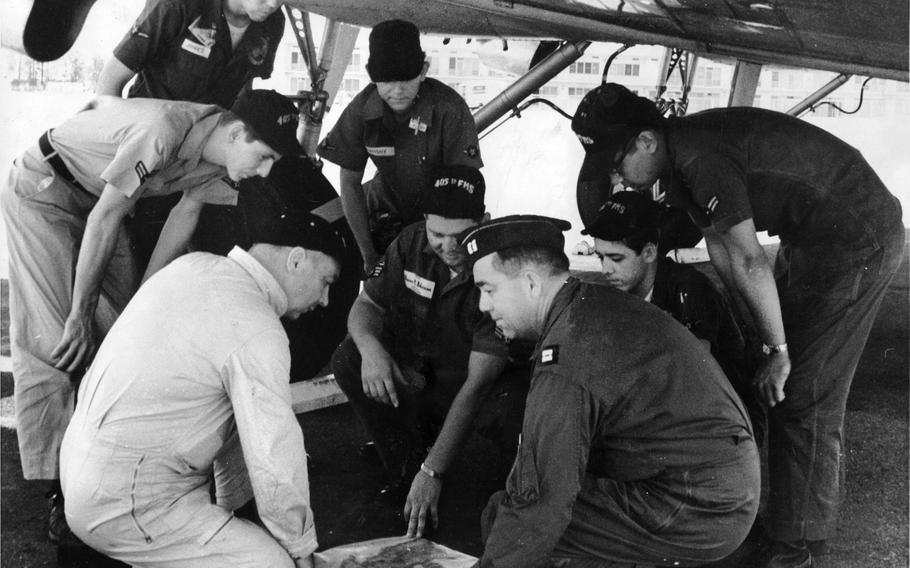
Crew members and volunteer “scanners” talk over the six-hour search and rescue mission searching for the Flying Tiger Airline Super Constellation that disappeared over the Western Pacific Ocean March 16, 1962. (Lee Pearlman/Stars and Stripes)
This article first appeared in the Stars and Stripes Pacific edition, March 20, 1962. It is republished unedited in its original form.
(EDITOR’S NOTE: Air Force S/Sgt. Robert G. Fisher, Pacific , Stars and Stripes Philippines Bureau Chief, flew one of the search missions for the missing American Constellation airliner in the Southwest Pacific).
CLARK AB, P.I. — Even the general’s personal plane is being used here to help search for some trace of the MATS-[Military Air Transport Service] chartered [sic] transport that disappeared Thursday night with 107 persons aboard.
And, a six-hour stint of trying to catch sight of debris, or survivors, on a wind-tossed sea is an eye-straining, bone-tiring experience.
The C-47 Douglas Skytrain used by Maj. Gen. Theodore R. Milton, commander, Thirteenth Air Force, was already warming up its engines as I jumped out of the flight truck shortly before 6 a.m.
I handed my camera gear up to the crew chief, A/1C Jim Johnson, of Hannibal, Mo., who pulled me into the plane’s cabin.
The door slammed shut and the plane taxied toward the end of the runway. Johnson slipped a life preserver over my shoulders, adjusted it, showed me a seat just forward of the right wing, and handed me a pair of binoculars.
Minutes later we were traversing the planned flight path of the missing Flying Tiger Constellation that disappeared Thursday night [March 16, 1962] with 107 persons aboard.
The pilot, Capt. Theodore Stewart of the 405th Fighter Wing at Clark turned eastward over Lamon Bay, skirting the north coast of the Philippine provinces of Camarines Norte and Camerines Sur. Co-pilot Capt. Lawrence R. Brosy of Hq., Thirteenth Air Force, checked the progress of the plane on a series of maps.
At other windows were A/2C Robert L. Jones, A/3C Dennis Jones, A/1C David K. Crausby, A/8C Lawrence L. Clatchey and .A/2C Edward M. Raquel, assistant crew chief. They are all assigned to the 405th Field Maint. Sq. at Clark.
Our plane’s search area was bounded by 14 degrees and 15 degrees north latitude and was 123 degrees and 124 degrees east longitude.
The plane would cross the square west to east along the southern boundary, then return east to west several miles further north, and so on, back and forth. Later the search route called for similar scanning in the square north and south.
Within 50 miles after leaving the coast of the Philippines, the plane ran into the first of a series of line squalls. What had been bright, hot, brilliant skies and relatively calm seas now changed into dull, grey, bumpy weather that obscured everything from view beyond several hundred feet.
Stewart at times flew the plane just above the waves in an effort to get maximum visibility in spite of the rain. Binoculars were little help. Streaks of water blurred the window.
After several minutes the plane broke into the clear again, but other lines of squalls stretched along the horizon.
We were completely out of sight of land, and the water was a dark gun-metal blue. Several hours of staring in one direction began to have a hypnotic effect.
Occasional dark spots on the water would twist themselves into weird shapes. I imagined a man’s head, and expected an arm to stretch upward and wave at the plane.
But through binoculars, the dark patch was nothing more than the shadow thrown by a cresting wave.
Another time, a large dark area turned out to be a shark or whale. False sightings were more frequent now. The constant droning of the plane and the strain of being anxious and eager to discover something for so long began to tell on some of the scanners.
Some of us changed places just to break the monotony.
Lunch was good. The cool milk was refreshing and cleared up the cobwebs that seemed to be forming over my eyes. Then, coffee and a cigarette.
Suddenly the plane pulled up sharply and turned west. We were returning to the base after a six-hour unsuccessful search.
As we crossed over the coast some of the scanners dropped off to sleep.
Arriving at Clark, I noticed other planes were loading with new crews and scanner teams. The search would go on and on until all hope was exhausted.
Archivist note: The plane, nor any of its passengers and crew were found despite one of the largest air and sea search operations to date. Want to know more? Find additional reporting by Stars and Stripes in our historic archives https://starsandstripes.newspaperarchive.com/